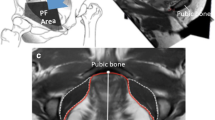Abstract
In women with genital prolapse, damage to the pelvic floor muscles, fasciae, and ligaments leads to characteristic changes in the shape and position of the vagina. This observational study was undertaken to determine how these changes can be used to document damage to individual pelvic floor structures. Resting and straining radiographs in the standing position with barium in the vagina were made of 23 women with normal and 31 women with abnormal support, and correlated with anatomic studies of 23 cadavers. These studies demonstrate that the downward sagging of the upper vagina seen in frontal radiographs reflects a failure of the cardinal-uterosacral complex. Loss of the lateral indentations in the lower vagina indicates loss of the constricting effects of the levator ani. In lateral radiographs the levator plate's inclination can be measured. The distance between the pubic symphysis and anterior perineal body indicates the levator ani muscles' closure of the vagina. A line from the lower pubic symphysis to the ischial spine represents the location of the arcus tendineus fasciae pelvis. The distance between this line and the anterior vaginal wall indicates the status of the pubocervical fascia and its attachment to the arcus. With these observations, the vaginogram can be used to examine the status of the fascial and muscular supports of the vagina. It offers a research tool for the study of individual parts of the supportive system, and can be applied to such questions as the frequency of damage to muscles, fasciae or ligaments in recurrent prolapse.
Similar content being viewed by others
References
Halban J, Tandler J. Anatomie and Atiologie der Genital prolapse biem Weibe. Vienna and Leipzig: Wilhelm Braumuller, 1907
Fothergil WE. On the pathology and the operative treatment of displacements of the pelvic viscera. J Obstet Gynaecol Br Emp 1908;13:410–419
Paramore RH. The supports-in-chief of the female pelvic viscera. J Obstet Gynaecol Br Emp 1908;13:391–409
Bonney V. The principles that should underlie all operations for prolapse. J Obstet Gynaecol Br Emp 1934;41:669–683
Mengert WF. Mechanics of uterine support and position I. Factors influencing uterine support (an experimental study). Am J Obstet Gynecol 1936;31:775–782
Ricci JV, Lisa JR, Thom CH, Kron WL. The relationship of the vagina to adjacent organs in reconstructive surgery. Am J Surg 1947;74:387–410
Berglas B, Rubin IC. Histologic study of the pelvic connective tissue. Surg Gynecol Obstet 1957;97:227–289
Richardson AC, Lyons JB, Williams NL. A new look at pelvic relaxation. Am J Obstet Gynecol 1976;126:568–573
Nichols DH, Randall CL. Vaginal surgery, 3rd ed. Baltimore: Williams and Wilkins, 1989
Richter K. Lebendige Anatomie der Vagina. Geburts Frauenheik 1966;26:1213–1223
Hodgkinson CP. Metallic bead-chain urethrocystography in preoperative and postoperative evaluation of gynecologic urology problems. Clin Obstet Gynecol 1978;21:725–735
Porges RF, Porges JC, Blinick G. Mechanisms of uterine support and the pathogenesis of uterine prolapse. Obstet Gynecol 1960;15:711–726
Berglas B, Rubin IC. Study of the supportive structures of the uterus by levator myography. Surg Gynecol Obstet 1953;97:677–692
Parks AG, Porter NH, Melzak J. Experimental study of the reflex mechanism controlling muscles of the pelvic floor. Dis Colon Rec 1962;5:407–414
Jeffcoate TNA, Roberts H. Observations on stress incontinence of urine. Am J Obstet Gynecol 1952;64:721–738
Green TH. Development of a plan for the diagnosis and treatment of urinary stress incontinence. Am J Obstet Gynecol 1962;83:632–648
deMarsovszky JP, Nichols DH, Randall CL. Urethrocolopography. Arch Gynäkol 1973;215:351–358
Funt MI, Thompson JD, Birch H. Normal vaginal axis. South Med 1978;71:1534–1535
Bethoux A, Bory S, Huguier M. Une technique radiologique d'exploration des prolapses genitaux et des incontinences d'urine: le colpocystogramme. Ann Radiol (Paris) 1965;8:809–828
Lazarevski M, Lazarov A, Novak J, Dimcevski D. Colpocystography in cases of genital prolapse and urinary stress incontinence in women. Am J Obstet Gynecol 1975;122:704–716
Lash AF, Levin B. Roentgenographic diagnosis of vaginal vault hernia. Obstet Gynecol 1962;20:427–433
Goff BH. The surgical anatomy of cystocele and urethrocele with special reference to the pubocervical fascia. Surg Gynecol Obstet 1948;87:725–734
Range RL, Woodburne RT. The gross and microscopic anatomy of the transverse cervical ligaments. Am J Obstet Gynecol 1964;90:460–467
Campbell RM. The anatomy and histology of the sacrouterine ligaments. Am J Obstet Gynecol 1950;59:1–12
Smith ARB, Hosker GL, Warrell DW. The role of partial denervation of the pelvic floor in the aetiology of genitourinary prolapse and stress incontinence or urine: a neurophysiological study. Br J Obstet Gynaecol 1989;96:24–28.
Author information
Authors and Affiliations
Rights and permissions
About this article
Cite this article
DeLancey, J.O.L. Vaginographic examination of the pelvic floor. Int Urogynecol J 5, 19–24 (1994). https://doi.org/10.1007/BF00451707
Issue Date:
DOI: https://doi.org/10.1007/BF00451707




